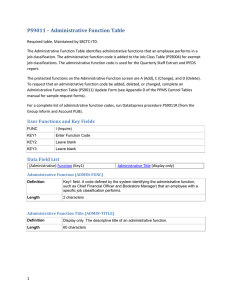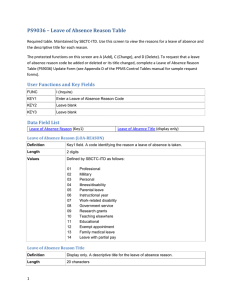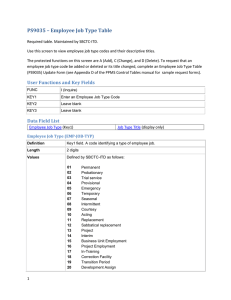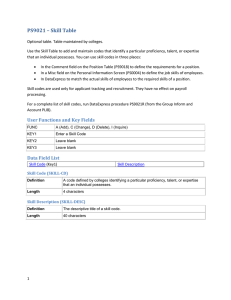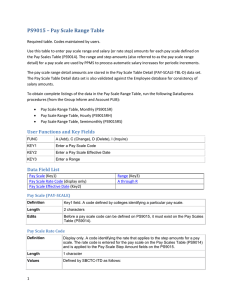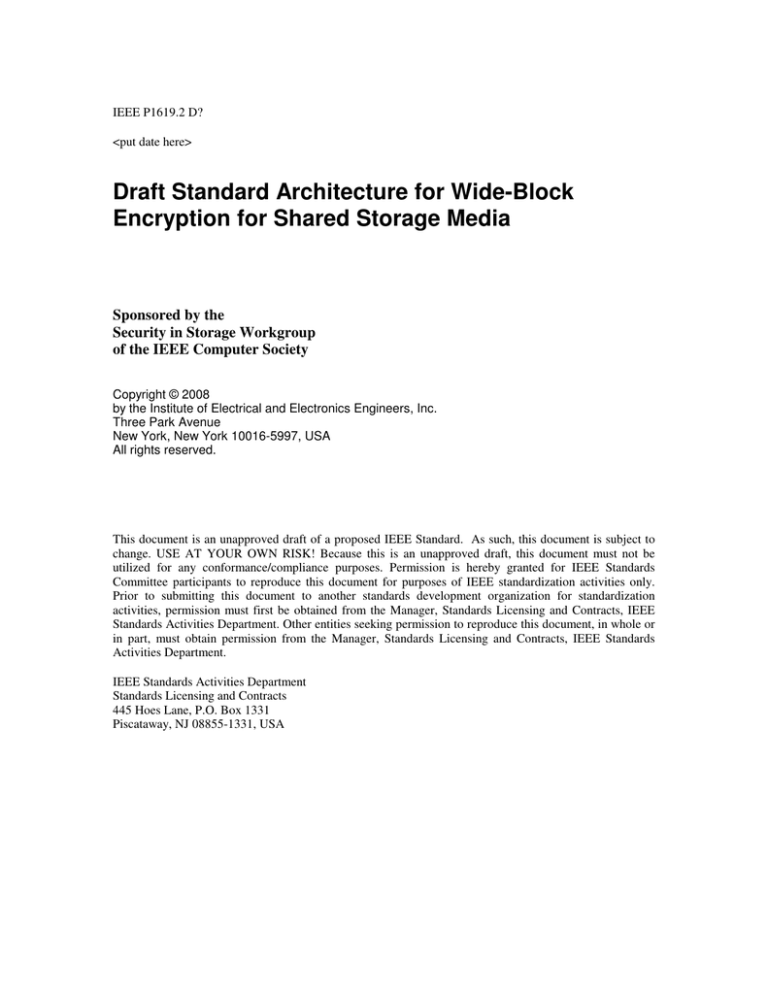
IEEE P1619.2 D?
<put date here>
Draft Standard Architecture for Wide-Block
Encryption for Shared Storage Media
Sponsored by the
Security in Storage Workgroup
of the IEEE Computer Society
Copyright © 2008
by the Institute of Electrical and Electronics Engineers, Inc.
Three Park Avenue
New York, New York 10016-5997, USA
All rights reserved.
This document is an unapproved draft of a proposed IEEE Standard. As such, this document is subject to
change. USE AT YOUR OWN RISK! Because this is an unapproved draft, this document must not be
utilized for any conformance/compliance purposes. Permission is hereby granted for IEEE Standards
Committee participants to reproduce this document for purposes of IEEE standardization activities only.
Prior to submitting this document to another standards development organization for standardization
activities, permission must first be obtained from the Manager, Standards Licensing and Contracts, IEEE
Standards Activities Department. Other entities seeking permission to reproduce this document, in whole or
in part, must obtain permission from the Manager, Standards Licensing and Contracts, IEEE Standards
Activities Department.
IEEE Standards Activities Department
Standards Licensing and Contracts
445 Hoes Lane, P.O. Box 1331
Piscataway, NJ 08855-1331, USA
<put date here>
IEEE P1619.2/D?
Introduction
The purpose of IEEE1619.2 standard is …
At the time this standard was completed, the working group had the following membership:
The following members of the balloting committee voted on this standard. Balloters may have voted for
approval, disapproval, or abstention. (To be provided by IEEE editor at time of publication.)
Copyright © 2008 IEEE. All rights reserved.
This is an unapproved IEEE Standards Draft, subject to change.
ii
<put date here>
IEEE P1619.2/D?
Contents
Copyright © 2008 IEEE. All rights reserved.
This is an unapproved IEEE Standards Draft, subject to change.
iii
<put date here>
IEEE P1619.2/D?
Wide-Block Encryption for Shared Storage Media
1. Overview
1.1 Scope and Purpose
This standard specifies an architecture for encryption of data in random access storage devices, oriented
toward applications which benefit from wide encryption-block sizes of 512 bytes and above.
1.2 Related work
This standard specifies an architecture for media security and enabling components. Wide encryption
blocks are well suited to environments where the attacker has repeated access to cryptographic
communication or ciphertext, or is able to perform traffic analysis of data access patterns. The standard is
oriented toward fixed-size encryption blocks without data expansion, but anticipates an optional data
expansion mode to resist attacks involving data tampering.
2. References
The following referenced documents are indispensable for the application of this document. For dated
references, only the edition cited applies. For undated references, the latest edition of the referenced
document (including any amendments or corrigenda) applies.
NIST FIPS-197, Federal Information Processing Standard (FIPS) for the Advanced Encryption Standard.1
3. Definitions
None yet.
4. The XCB-AES Transform
Insert here the XCB draft.
5. The EME2-AES Transform
5.1 The Mult-by-alpha Operation
To be written.
1
FIPS publications are available from the National Technical Information Service (NTIS), 5285 Port Royal Road,
Springfield, VA, USA. FIPS-197 is also available on-line from http://csrc.nist.gov/CryptoToolkit/aes/
Copyright © 2008 IEEE. All rights reserved.
This is an unapproved IEEE Standards Draft, subject to change.
5
<put date here>
IEEE P1619.2/D?
5.1 EME2-AES Encryption
The EME2-AES encryption procedure can be described by the formula:
C = EME2-AES-Enc(Key, T, P),
where
Key is the 384 or 512 bit EME2-AES key
T is a tweak value, of arbitrary bit length (zero or more bits)
P is the plaintext, of length 128 bits or more
C is the ciphertext resulting from the operation, of the same bit-length as P
The input to the EME2-AES encryption routine is parsed as follows:
The key is partitioned into three fields, Key = Key1 | Key2 | Key3, with Key3 consisting of the last
128 bits, Key2 consisting of the 128 bits before them, and Key1 consisting of the remaining first
128 or 256 bits.
If not empty, the tweak is partitioned into a sequence of blocks T = T1 | T2 | … | Tr, where each of
the blocks T1, T2, …, Tr-1 is of length exactly 128 bits, and Tr is of length between 1 and 128 bits.
The plaintext P is partitioned into a sequence of blocks P = P1 | P2 | … | Pm, where each of the
blocks P1, P2, …, Pm-1 is of length exactly 128 bits, and Pm is of length between 1 and 128 bits.
The ciphertext shall then be computed by the sequence of steps in Figure 2 or equivalent. An illustration of
these steps (for plaintext of 129 full blocks and one partial block) is provided in Figure 1.
Figure 1. An illustration of EME2-AES
P2
P1
L
P127
126
α L
αL
AES
AES
PPP1
ΣPPPi⊕T*
P128
127
α L
AES
PPP2
…
α M1
AES
PPP130
αM2
MM
MC2
MC1
M1
CCC1
CCC2
AES
CCC127
AES
AES
α126L
αL
C1
PPP129
MP2
αM1
L
PPP128
126
AES
ΣCCCi⊕T*
pad with
100...0
AES
M1
AES
MM
P130
α L
AES
PPP127
MP1
P129
128
C2
CCC128
AES
α127L
C127
CCC129
CCC130
pad with
100...0
AES
α128L
C128
C129
Copyright © 2008 IEEE. All rights reserved.
This is an unapproved IEEE Standards Draft, subject to change.
C130
6
<put date here>
IEEE P1619.2/D?
Figure 2. The EME2-AES Encryption Procedure
// Process the tweak T to get the 128-bit block T_star
1. if len(T)==0 then T_star = AES-Enc(Key1, Key3)
2. else
3.
Key3 = Mult-by-alpha(Key3)
4.
for i=1 to r-1
5.
TTi = AES-Enc(Key1, Key3⊕Ti) ⊕ Key3
6.
Key3 = Mult-by-alpha(Key3)
7.
If len(Tr)<128 then
8.
Tr = Tr | 10…0
// pad Tr to 128 bits
9.
Key3 = Mult-by-alpha(Key3)
10.
TTr = AES-Enc(Key1, Key3⊕Tr) ⊕ Key3
11.
T_star = TT1 ⊕ TT2 ⊕ … ⊕ TTr
// First ECB pass
12. L = Key2
13. for i=1 to m-1
14.
PPPi = AES-Enc(Key1, L⊕Pi)
15.
L = Mult-by-alpha(L)
16. if len(Pm)<128 then PPPm = Pm | 10…0 // pad Pm to 128 bits
17. else
PPPm = AES-Enc(Key1, L⊕Pm)
// Intermeidate mixing
18. MP = PPP1 ⊕ PPP2 ⊕ … ⊕ PPPm ⊕ T_star
19. if len(Pm)<128 then
20.
MM = AES-Enc(Key1, MP)
21.
MC = MC1 = AES-Enc(Key1, MM)
22. else MC = MC1 = AES-Enc(Key1, MP)
23. M = M1 = MP ⊕ MC
24. for i=2 to m-1
25.
if (i-1 mod 128 > 0) then
26.
M = Mult-by-alpha(M)
27.
CCCi = PPPi ⊕ M
28.
else
29.
MP = PPPi ⊕ M1
30.
MC = AES-Enc(Key1, MP)
31.
M = MP ⊕ MC
32.
CCCi = MC ⊕ M1
33. if len(Pm)<128 then
34.
Cm = Pm ⊕ (MM truncated to len(Pm) bits)
35.
CCCm = Cm | 10…0 // pad Cm to 128 bits
36. else if (m-1 mod 128 > 0) then
37.
M = Mult-by-alpha(M)
38.
CCCm = PPPm ⊕ M
39. else CCCm = AES-Enc(Key1, M1⊕PPPm) ⊕ M1
40. CCC1 = MC1 ⊕ CCC2 ⊕ … ⊕ CCCm ⊕ T_star
// Second ECB Pass
41. L = Key2
42. for i=1 to m-1
43.
Ci = AES-Enc(Key1,CCCi) ⊕ L
44.
L = Mult-by-alpha(L)
45. if len(Pm)==128 then Cm = AES-Enc(Key1,CCCm) ⊕ L
Copyright © 2008 IEEE. All rights reserved.
This is an unapproved IEEE Standards Draft, subject to change.
7
<put date here>
IEEE P1619.2/D?
5.2 EME2-AES Decryption
The EME2-AES decryption procedure can be described by the formula:
C = EME2-AES-Dec(Key, T, C),
where
Key is the 256 or 384 bit EME2-AES key
T is a tweak value, of arbitrary bit length (zero or more bits)
C is the ciphertext, of length 128 bits or more
P is the plaintext resulting from the operation, of the same bit-length as C
The input to the EME2-AES decryption routine is parsed as follows:
The key is partitioned into three fields, Key = Key1 | Key2 | Key3, with Key3 consisting of the last
128 bits, Key2 consisting of the 128 bits before them, and Key1 consisting of the remaining first
128 or 256 bits.
If not empty, the tweak is partitioned into a sequence of blocks T = T1 | T2 | … | Tr, where each of
the blocks T1, T2, …, Tr-1 is of length exactly 128 bits, and Tr is of length between 1 and 128 bits.
The ciphertext P is partitioned into a sequence of blocks C = C1 | C2 | … | Cm, where each of the
blocks C1, C2, …, Cm-1 is of length exactly 128 bits, and Cm is of length between 1 and 128 bits.
The ciphertext shall then be computed by the sequence of steps in Figure 3 or equivalent. (Note that the
only difference between the encryption and decryption routines is that all the AES-Enc operations within
lines 12-45 are replaced by AES-Dec operations.
Figure 3. The EME2-AES Decryption routine
// Process the tweak T to get the 128-bit block T_star
1. if len(T)==0 then T_star = AES-Enc(Key1, Key3)
2. else
3.
Key3 = Mult-by-alpha(Key3)
4.
for i=1 to r-1
5.
TTi = AES-Enc(Key1, Key3⊕Ti) ⊕ Key3
6.
Key3 = Mult-by-alpha(Key3)
7.
If len(Tr)<128 then
8.
Tr = Tr | 10…0
// pad Tr to 128 bits
9.
Key3 = Mult-by-alpha(Key3)
10.
TTr = AES-Enc(Key1, Key3⊕Tr) ⊕ Key3
11.
T_star = TT1 ⊕ TT2 ⊕ … ⊕ TTr
// First ECB pass
12. L = Key2
13. for i=1 to m-1
14.
CCCi = AES-Dec(Key1, L⊕Ci)
15.
L = Mult-by-alpha(L)
16. if len(Cm)<128 then CCCm = Cm | 10…0 // pad Cm to 128 bits
17. else
CCCm = AES-Dec(Key1, L⊕Cm)
// Intermeidate mixing
18. MC = CCC1 ⊕ CCC2 ⊕ … ⊕ CCCm ⊕ T_star
19. if len(Cm)<128 then
20.
MM = AES-Dec(Key1, MC)
21.
MP = MP1 = AES-Dec(Key1, MM)
22. else MP = MP1 = AES-Dec(Key1, MC)
Copyright © 2008 IEEE. All rights reserved.
This is an unapproved IEEE Standards Draft, subject to change.
8
<put date here>
IEEE P1619.2/D?
23. M = M1 = MP ⊕ MC
24. for i=2 to m-1
25.
if (i-1 mod 128 > 0) then
26.
M = Mult-by-alpha(M)
27.
PPPi = CCCi ⊕ M
28.
else
29.
MC = CCCi ⊕ M1
30.
MP = AES-Dec(Key1, MC)
31.
M = MP ⊕ MC
32.
PPPi = MP ⊕ M1
33. if len(Cm)<128 then
34.
Pm = Cm ⊕ (MM truncated to len(Cm) bits)
35.
PPPm = Pm | 10…0 // pad Pm to 128 bits
36. else if (m-1 mod 128 > 0) then
37.
M = Mult-by-alpha(M)
38.
PPPm = CCCm ⊕ M
39. else PPPm = AES-Dec(Key1, M1⊕CCCm) ⊕ M1
40. PPP1 = MP1 ⊕ PPP2 ⊕ … ⊕ PPPm ⊕ T_star
// Second ECB Pass
41. L = Key2
42. for i=1 to m-1
43.
Pi = AES-Dec(Key1,PPPi) ⊕ L
44.
L = Mult-by-alpha(L)
45. if len(Cm)==128 then Pm = AES-Dec(Key1, PPPm) ⊕ L
Copyright © 2008 IEEE. All rights reserved.
This is an unapproved IEEE Standards Draft, subject to change.
9
<put date here>
IEEE P1619.2/D?
Annex A: Bibliography (informative)
Copyright © 2008 IEEE. All rights reserved.
This is an unapproved IEEE Standards Draft, subject to change.
10

